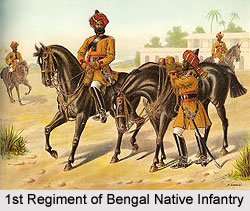 The 1st Regiment of Bengal Native Infantry was mainly an infantry regiment of the Bengal Native Infantry under the British East India Company. It was a part of the Army of the province of Bengal before the beginning of the Great Revolt or Sepoy Mutiny of 1857. The Bengal Army was the armed forces of Bengal Presidency and was amongst the 3 main Presidency Armies in British India. The 1st Regiment of Bengal Native Infantry was also known as the 1st Brahman Infantry.
The 1st Regiment of Bengal Native Infantry was mainly an infantry regiment of the Bengal Native Infantry under the British East India Company. It was a part of the Army of the province of Bengal before the beginning of the Great Revolt or Sepoy Mutiny of 1857. The Bengal Army was the armed forces of Bengal Presidency and was amongst the 3 main Presidency Armies in British India. The 1st Regiment of Bengal Native Infantry was also known as the 1st Brahman Infantry.
History of 1st Regiment of Bengal Native Infantry
The 1st Regiment of Bengal Native Infantry was developed by Captain T. Naylor at Oudh in the year 1776. The purpose of the regiment was to provide service in the Nawab Wazir`s Regiment, which was the armed force of Nawab Wazir of Oudh. In the following year, the 1st Brahmans regiment was reassigned to the British East India Company in 1777. Later in the year 1922, the regiment was assigned as the 4th Battalion 1st Punjab Regiment. The 1st Regiment of Bengal Native Infantry was dissolved in 1931.
Designations of 1st Regiment of Bengal Native Infantry
The 1st Brahmans battalion of the British Indian Army occupied several designations through out its existence. These are mentioned below-
* Nawab Wazir`s Regiment (1776)
* 30th Battalion of Bengal Sepoys (1777)
* 23rd Regiment of Bengal Sepoys (1781)
* 29th Regiment of Bengal Sepoys (1784)
* 29th Bengal Sepoy Battalion (1786)
* 2nd Battalion 9th Regiment of Bengal Native Infantry (1796)
* 21st Regiment of Bengal Native Infantry (1824)
* 1st Regiment of Bengal Native Infantry (1861)
* 1st Regiment of Bengal Infantry (1885)
* 1st Brahman Infantry (1901)
* 1st Brahmans (1903)
* British and Indian officers of the 1st Brahmans (1912)
* 4th Battalion 1st Punjab Regiment (1922)
Operations of 1st Regiment of Bengal Native Infantry
The 1st Regiment of Bengal Native Infantry granted battle honours for its significant service in the Second Anglo Maratha War during 1803 to 1805. While the regiment was under the British East India Company, it also participated in the Anglo Nepalese War from 1814 to 1816, the Second Anglo Burmese War from 1824 to 1826 and the Bharatpur (Bhurtpore) Campaign in the year 1826 and was awarded battle honours. The 1st Regiment was ranked highest in terms of seniority amongst the 12 Bengal Native Infantry regiments, which existed even after the Sepoy Mutiny or Indian rebellion of 1857- 1858.
Development of 1st Regiment of Bengal Native Infantry
The unit was reorganized and renumbered as the 1st battalion of the Bengal presidency army. Eventually the regiment served in the Third Anglo Burmese War from 1885 to 1887. In the year 1901, the regiment was renamed as the 1st Brahman Infantry, when the titles of the British Indian presidencies were omitted after the Kitchener reforms of the British Indian Army. The regimental centre of the 1st Regiment of Bengal Native Infantry was established at Allahabad in 1914 and the regiment was tied with the 3rd Brahman Infantry. The army unit was recruited from Garhwali Brahmins, United Provinces Brahmins and few Punjabi Mussalmans.
The full uniform of the troops or Sepoys consisted of a scarlet long coat or kurta with white facings, dark blue trousers and white leggings, white waist-sash and a high khaki turban with red fringe. The 1st Regiment of Bengal Native Infantry served in British dominated India during the First World War. In the year 1917, a 2nd battalion was developed which served in the Persian Gulf. The 1st Brahman Infantry was greatly restructured after the war and was reassigned to the British Indian Army. The separate single- battalion infantry regiments were merged together in order to develop more prominent regiments of around 6 battalions.
Dissolution of 1st Regiment of Bengal Native Infantry
Later in 1922, the regiment was modernized as the 4th Battalion of the 1st Punjab Regiment. But the army unit was dissolved due to curtailment and retrenchment in the British Indian Army in the year in 1931.



















